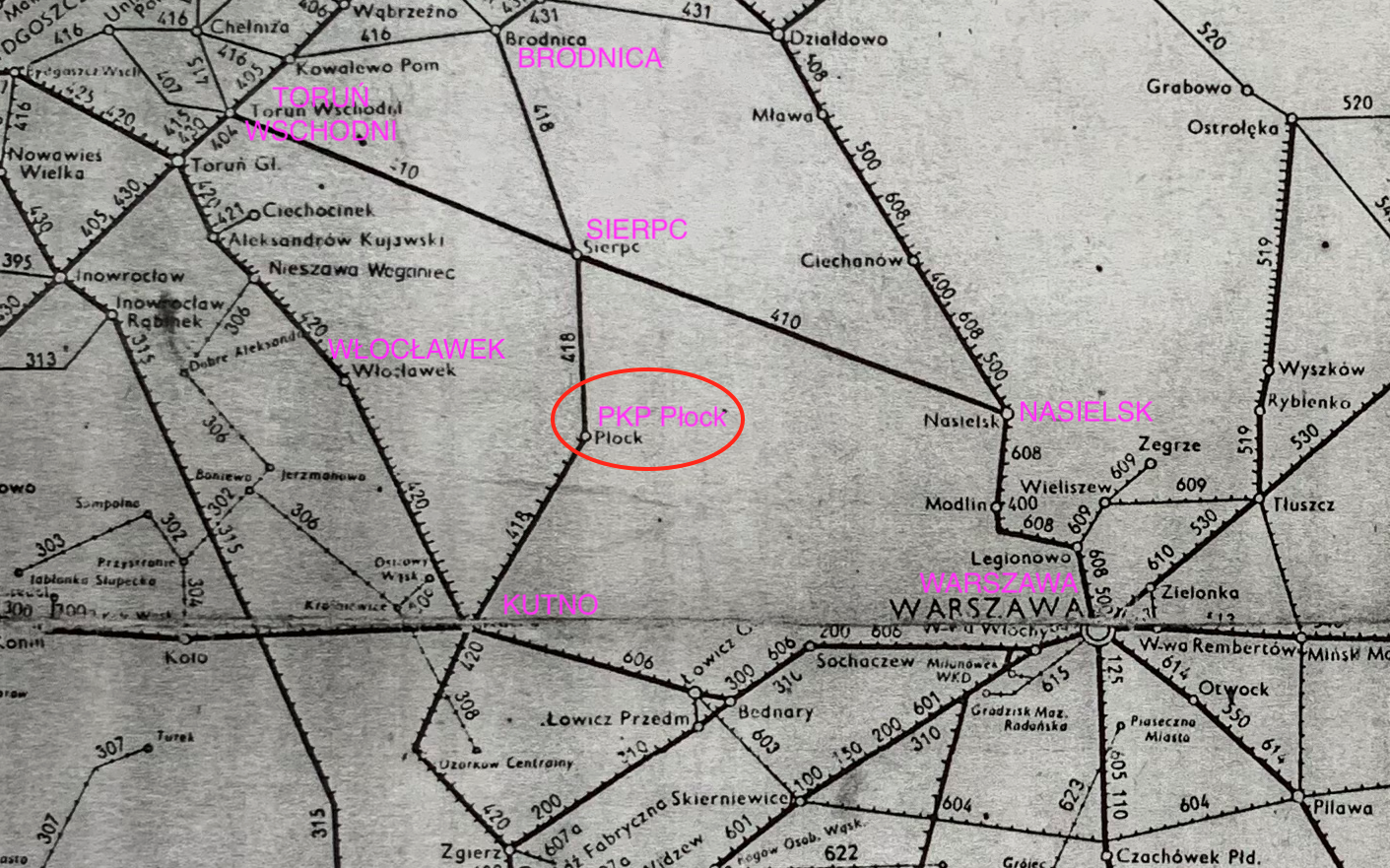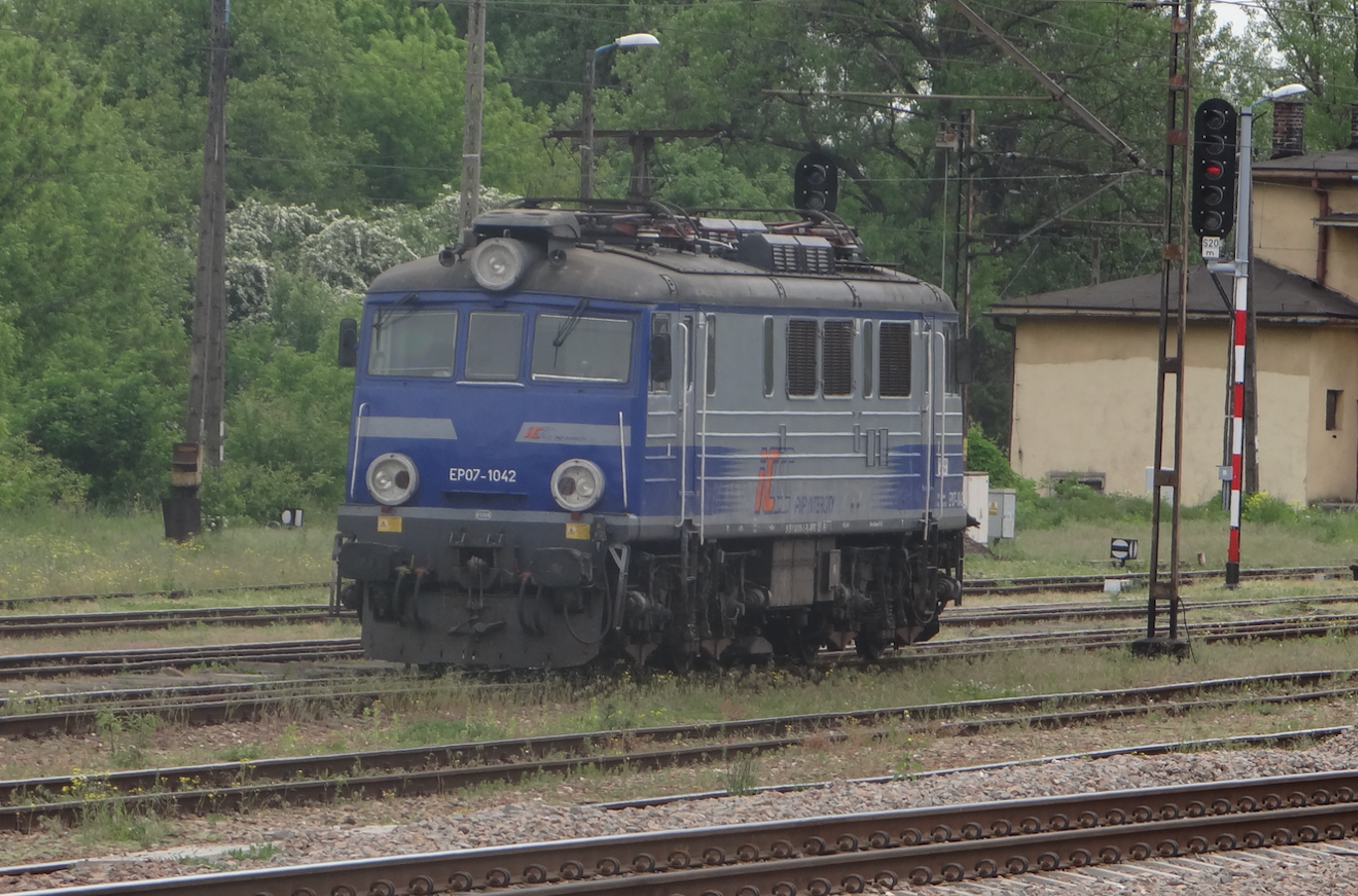Płock 2022-12-06
Railway station in Płock.
Płock is a Polish city that has a 1,000-year history and was also the capital of Poland. Płock is a large city in central Poland, which currently has poviat rights. The city is located in the Dobrzyń Lake District, in the Płock Valley, on the Vistula River, in the Mazowieckie Voivodeship. A resident of Płock was a fighter pilot Jan Zumbach, who was the commander of the legendary 303 Squadron.



Płock bridges over the Vistula.
In Płock, the first known bridge was built in 1410 to cross the Polish Army going to the Grunwald Fields. It is possible that later makeshift wooden bridges could also be built, mainly for the needs of army crossings. Certainly, since the 16th century, ferries ran across the Vistula.
The first well-known and documented bridge was a wooden skate bridge, which was built in 1838. A skate bridge is a wooden bridge that is supported by boats called skates. For the winter period, the bridge was dismantled so that the ice flowing down in the spring would not destroy it. In 1888, the cities of Płock and Włocławek turned into skate bridges. The bridge from Włocławek was newer, but narrower. The bridge served the inhabitants of Płock until the outbreak of the Great World War, which was started by the Germans. The bridge was destroyed in August 1914 by Moscow troops. During the Great World War, a makeshift wooden bridge was built for the army. But that bridge was destroyed too.
In May 1916, the Germans built another wooden bridge. No inhabitant of Płock came to the ceremonial opening. The bridge was supported on 12 stone supports, in front of which ice fenders were built. This bridge survived until the times of reborn Poland. The bridge was regularly repaired due to its natural wear and tear. The bridge was planned to be dismantled after the metal bridge was commissioned. This was not done because Germans and Muscovites attacked Poland.
The metal road-rail bridge was built in December 1938. The bridge was very modern, with trusses placed under the roadway, which allowed for its future widening. In September 1939, the bridge was partially destroyed by the Polish Army. In 1944, it was rebuilt by the Germans and blown up again on January 20, 1945. The bridge was rebuilt in June 1950 and is named after the "Legions of Józef Piłsudski". In 1977, the road-rail bridge underwent a major renovation. A makeshift bridge was built by the military for the duration of the renovation. Another renovation of the bridge took place in 1994. A temporary bridge was prepared again for the duration of the renovation. This type of renovation is not unusual. Bridges are being repaired because the weight of trucks and freight trains is increasing. The last renovation was carried out in 2005. Since 2009, the bridge has been illuminated in three colors, referring to the colors of the city flag: yellow, red and blue. It is the longest colored bridge illumination in the world, 690 m long.
The new bridge over the Vistula was built as part of the eastern ring road of Płock, along the National Road No. 60. In 2007, it was ceremonially opened along with access roads. The bridge was named "Solidarity Bridge". The bridge has two 65-meter pylons, to which 5 spans are suspended on ropes, including the longest main span in Poland with a span of 375 m. In this construction, it is the longest bridge in the world. The new bridge is 1,200 m long and 27.5 m wide, with a footpath, bicycle path and four traffic lanes.
PKP Płock.
Geographic coordinates: 52.552N 19.714E.
The second half of the 19th century in Europe saw the dynamic development of railways. But not in every area. Płock and most of Mazovia at that time was under the Muscovite Partition. The Muscovite state was inefficiently governed at that time and was in constant crisis. This state did not treat the railway as an opportunity to develop and improve the living conditions of the inhabitants, but as a military element. Therefore, they treated every railway line as an opportunity for a lightning attack by the enemy. As a result, the railway network in Mazovia was small. What's more, the railway line has not been brought to such a large city as Płock.
It was only after the Republic of Poland regained its independence in 1918 that the construction of a railway line to Płock from Kutno began. On January 15, 1922, the 46 km, single-track section Kutno - Płock Radziwie was opened. The Płock Radziwie station is located on the left bank of the Vistula. In this way, Płock gained a railway connection with Warsaw and southern Poland. The inhabitants of Płock still had to cross the bridge over the Vistula. The opening of the station on January 15, 1922 was the first technical opening. The final ceremonial opening took place on October 25, 1925. Since then, the inhabitants of Płock can travel by train to Warsaw.
On November 19, 1934, a 35 km, 1-track section from Płock to Sierpc was put into use. This track made it possible to travel by rail from Płock to the north, towards Grudziądz, Olsztyn and Gdańsk. The next section of Sierpc - Brodnica was opened on September 25, 1937.
The Płock Radziwie railway station and the Płock railway station did not have a railway connection, because there was no railway bridge over the Vistula. Design work on the new bridge began in 1930. The road and railway bridge over the Vistula was built and officially opened in December 1938. In this way, the missing 6.5 km of track was built. The first trains ran along the route in December 1938.
It is worth adding that the railway line in Płock had to be routed avoiding the Vistula escarpment. Therefore, after crossing the Vistula, the tracks turn right towards the east. Then the tracks turn left towards the north-east and again after about 1 km, left towards the north-west and reach the Płock station.
Płock enjoyed a new railway connection for a short time, because the German army invaded Poland together with the Soviet army. During the defensive war, the Polish Army blew up one span of the rail-road bridge to hinder the march of the Germanic plague. In 1944, the bridge over the Vistula was repaired. But already on January 20, 1945, the German army blew up the bridge to hinder the march of the Soviet army. Poland, ruined by the war, did not have the strength to immediately rebuild the bridges on the Vistula River that had been destroyed. The bridge in Płock was rebuilt in June 1950.
In 1948, the Kutno - Płock Radziwie railway line was No. 418, and the Płock - Sierpc - Brodnica line was No. 416. After the bridge over the Vistula was rebuilt, the Kutno - Płock - Sierpc - Brodnica section was No. 418. The entire line was made as a single- track, but all engineering structures were prepared for the construction of the second track. In 1977, the second track was opened on the Płock Radziwie - Łąck section. To date (2022), no second track has been built along the entire route.
Currently, the entire railway line No. 33 Kutno - Brodnica is 142.847 km long. In recent years, the trail has been systematically modernized. In 2021, after a long-term suspension of traffic on the Płock - Brodnica section, passenger traffic returned along the entire route. The maximum speed is 100 km/h, but it is possible to increase the speed, because the trail runs along very long straight sections. Numerous rail-road intersections are a big problem, because the inhabitants are used to low rail traffic, especially on the section Płock - Sierpc - Brodnica.
The entire railway line No. 33 Kutno - Brodnica was to be electrified. The first section of Kutno - Florek was electrified on May 31, 1980. On November 27, 1984, the Florek - Płock Trzepowo section was electrified. As a result, the refinery in Płock is operated by electric traction. The remaining route has not yet been electrified.
The Płock railway station became a local railway junction. The railway siding from the Płock Radziwie station to the port was expanded, where the Płock Radzicie Port railway station was built. There was also a railway siding from the Płock station to the industrial areas of Płock - Harvesting Machines Factory and a former siding to the military unit (Wacława Lechman Street). Along with the construction of the refinery, the Płock Trzepowo railway station was built, north of the city. The railway sidings to the Refinery and Petrochemia depart from this station.
Płock is the largest railway station in Płock. It is located about 1 km from the city center, at Dworcowa Street. In 2019, the station served about 500 passengers a day.
The train station is located on the south side of the station, facing the city. The building was built in 1935, in accordance with the standards of the time, and has been in use until now (2022). The building of the railway station is also a bus station. Access to the station is very good. The following streets lead to the station: Dworcowa, Adama Mickiewicza, and Fryderyka Chopina. In 2014, the station building underwent a general renovation, which cost PLN 15 million. The station is open during the day and closed at night.
Currently, you can get from Płocka to: Gdynia InterCity "Flisak", Katowice InterCity "Rafters", Katowice InterCity "Chemik", Warszawa Wschodnia Koleje Mazowieckie "Mazovia", Kutno 9 trains Koleje Mazowieckie, Sierpc 10 trains Koleje Mazowieckie. There are 23 trains in total during the day. The "Flisak" train is interesting, which on the Płock - Gdynia section has a diesel traction locomotive (usually Czech Draha No. 749), and on the Płock - Katowice section it has an EU07 or EP07 electric locomotive. At the same time, trains of opposite relations meet at the station in Płock. This is where the locomotives are swapped.
There are two platforms and three platform edges at the station. Access to the platforms is provided by a footbridge over the tracks. Shape semaphores are still active at the station. Railway traffic is directed from one signal box.
Let us remember that there was also a narrow-gauge railway in Płock. One ran to the Borowiczki sugar factory, which was connected by a standard-gauge line near the crossing on Bielska Street. The second cableway connecting the Płock Radziwie station with the paper mill in Soczewka.
Written by Karol Placha Hetman
